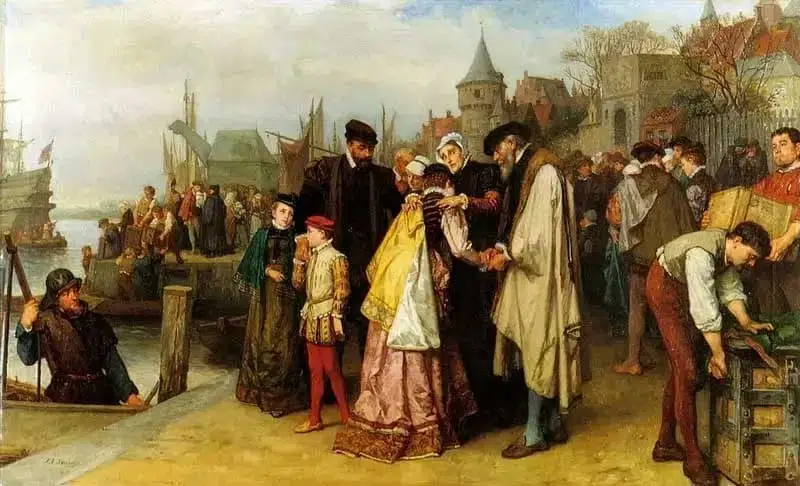In the sixteenth and seventeenth centuries (the 1500s & 1600s), Protestants in France who followed the teachings of John Calvin were known as Huguenots. They were also referred to as French Protestants, members of the Reformed Church, and Calvinists. Calvin was a French theologian who rose to prominence in the Protestant Reformation of the sixteenth century (the 1500s).
Calvin’s intellectual and unemotional approach to faith made him renowned. His methodologies appealed to well-educated French people, attracting some of the most intelligent, prominent, and elite members of society. Although France was primarily Catholic, the French crown tolerated Calvinism at first, due to the influence of those that followed Calvin and his teachings.
However, the French government continued to persecute them throughout the 1500s and 1600s, forcing the Huguenots to flee the country. This led to the establishment of Huguenot settlements in other parts of Europe, the modern-day United States, and Africa.
Quick Growth
French Protestants, also called French Calvinists, established the first Huguenot church in a private home in Paris in 1560. While the origins of the word “Huguenot” are unknown, many believe it is a combination of German and Flemish words. It combines the Flemish term “Huisgenooten,” meaning “house fellows,” with the German term “Eidgenosen,” meaning “confederates bound together by oath.” The rise of the Protestant churches in France was astounding. And, just two years later, in 1562, there were more than two million Huguenots in France and more than two thousand churches scattered throughout the country.
Catholic Resistance
Despite the quick growth of the Huguenot church, France was still more than ninety percent Catholic. Even with members of the nobility, intellectual elite, and the royal houses of Navarre, Valois, and Condé on the side of the Huguenots, they could not fight the resistance they faced from Roman Catholics that were still dominant all over France.
Although French Roman Catholics initially gave Huguenots a lot of leeway, they soon started making moves to control power in the country. The rapid expansion of the Huguenot movement posed a threat to the crown. This was something that the Catholics in power at the time were not going to tolerate.
Saint Bartholomew’s Day Massacre
The Huguenots were persecuted hugely while at the same time being given high favor by the crown. Over time, this flip-flopping between persecution and favor led to countless clashes between the Huguenots and Roman Catholics. In the 1560s, these clashes escalated with more and more blood being spilled until, eventually, the Queen of France, Catherine de Medici planned a horrendous attack.
On August 24th, 1572 – the feast day of Saint Bartholomew – thousands of Huguenots had gathered in Paris for a day of peaceful wedding celebrations. Henry of Navarre, who would go on to become the King of France from 1589 to 1610, was due to marry Margaret de Valois, a French princess of the Valois dynasty and daughter of Catherine de Medici. With a large section of Huguenot nobility due to attend the event, this was the perfect opportunity for Catherine to plot an attack. Following her orders, organized mobs and soldiers descended on the Huguenots in Paris, murdering thousands of people in a horrific event that would become known as the Saint Bartholomew’s Day Massacre.
Civil Wars, Persecution, And Exile
Over the following years, several civil wars took place in France. In March of 1590, Prince Henry of Navarre led a Huguenot army to engage in a battle against the Catholic League at the Battle of Ivry in Northern France. The Huguenot forces emerged victorious in this confrontation, defeating the Catholic forces. In April 1598, King Henry IV signed the Edict of Nantes, granting the French Huguenots substantial rights in a country that was still predominantly Catholic. Henry was striving to end civil unrest in the country, aiming to separate religious and civil unity. His efforts paved the way for tolerance in France and laid the foundation for more peaceful coexistence between different religious groups. The Huguenots would have more freedom for the next hundred years until Louis XIV became king and revoked the Edict of Nantes.
After King Louis XIV issued a prohibition on the practice of the Huguenot religion, he ordered French Huguenots to renounce their beliefs and convert to the Catholic Church. The king’s decree aimed to enforce religious uniformity and eliminate Protestantism in France. Louis XIV sent more than three hundred thousand soldiers around the country to find anyone who continued to practice and confiscate their property. Louis XIV overturning the Edict of Nantes ultimately led to France losing more than five hundred thousand of its best citizens, as Huguenots fled the country in search of safe-haven in other countries, including the United States.
France Finally Grants Religious Freedom
After America became independent from Great Britain, Gilbert du Motier – better known as the Marquis de Lafayette – persuaded Louis XIV to establish an Edict of Toleration that would guarantee religious freedom to everyone living in France. After witnessing the resilience, bravery, and determination of the American leaders and discovering that many of them had Huguenot ancestry, he felt compelled to take action and could no longer tolerate the persecution of the Huguenots in France. Louis XIV granted the Edict of Toleration, also known as the Edict of Versailles, and officially adopted it into law in January 1788. This edict granted Huguenots the religious freedom they deserved.
